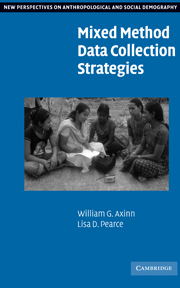Book contents
- Frontmatter
- Contents
- Acknowledgments
- Preface
- 1 Motivations for Mixed Method Social Research
- 2 Fitting Data Collection Methods to Research Aims
- 3 The Micro-Demographic Community Study Approach
- 4 Systematic Anomalous Case Analysis
- 5 Neighborhood History Calendars
- 6 Life History Calendars
- 7 Longitudinal Data Collection
- 8 Conclusion
- Notes
- Bibliography
- Index
7 - Longitudinal Data Collection
Published online by Cambridge University Press: 10 December 2009
- Frontmatter
- Contents
- Acknowledgments
- Preface
- 1 Motivations for Mixed Method Social Research
- 2 Fitting Data Collection Methods to Research Aims
- 3 The Micro-Demographic Community Study Approach
- 4 Systematic Anomalous Case Analysis
- 5 Neighborhood History Calendars
- 6 Life History Calendars
- 7 Longitudinal Data Collection
- 8 Conclusion
- Notes
- Bibliography
- Index
Summary
Over the last three decades of the 20th century, longitudinal research designs, in which the same people or other units of observation are measured repeatedly over time, have become social sciences' most powerful tools for studying cause and consequence. By measuring the same people over time, social scientists can better understand how conditions or characteristics at one time shape ideas, decisions, or outcomes at a later time. This approach also allows social scientists to ensure that the temporal order among measures matches the temporal order embedded in causal hypotheses themselves. In this sense, longitudinal measurement designs are similar to the calendar-type measurement designs described in Chapters 5 and 6. However, where calendar methods are explicitly retrospective, longitudinal designs are explicitly prospective, or intended to take measures forward over time. This gives longitudinal designs advantages for studying phenomena that are difficult to measure retrospectively, such as attitudes and values, mental health, relationship content and quality, or plans and expectations.
A key issue in the use of longitudinal data to answer questions of cause and consequence is that initial (time one) conditions or characteristics are rarely randomly assigned. Lack of random assignment violates a key aspect of experimental design and renders observed relationships open to the threat that they are the spurious product of some other unmeasured factor (Campbell and Stanley 1963; Winship and Morgan 1999).
- Type
- Chapter
- Information
- Mixed Method Data Collection Strategies , pp. 161 - 182Publisher: Cambridge University PressPrint publication year: 2006



